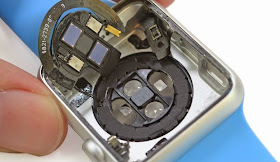Figure 1. Tear-down of Apple Watch reveals pulse oximeter (photo courtesy of iFixit).
What is pulse oximetry?
According to Wikipedia, "pulse oximetry is a non-invasive method for monitoring oxygen saturation." More specifically, it measures the percentage of hemoglobin in your blood that is bound to oxygen. Hemoglobin is an iron-containing protein that is the oxygen carrier in your blood, and is responsible for its red color. Typically, in a normal patient, 95-99% of the hemoglobin is loaded with oxygen. People with lung (pulmonary) diseases will have lower levels of oxygen saturation down to 92%.
Figure 2. Finger-tip pulse oximeter measures the absorbance by oxygenated blood of light transmitted through the finger.
A pulse oximetry sensor is placed on a thin part of the body (e.g. fingertip or earlobe) and then passes two beams of light through (transmissive) the body part measuring the amount of light that passes through with a photodiode detector (Figure 2). One beam is at a wavelength that is absorbed maximally by oxygenated hemoglobin (900 nm, infrared); the other beam is at a wavelength that is minimally absorbed by oxygenated blood and more strongly absorbed by de-oxygenated hemoglobin (700 nm, red). By calculating the ratio of the two absorbances, one can determine the percentage of hemoglobin bound to oxygen (Figure 3).
Figure 3. Absorption spectra of oxygenated hemoglobin (HbO2, red line) and deoxygenated hemoglobin (Hb, blue line) for red (700 nm) and infrared (900 nm) wavelengths (Wikipedia).
An alternative strategy is reflective pulse oximetry in which the two beams of light are reflected or scattered from the blood back to the surface where the detector is located alongside the light source. This is presumably how the Apple Watch works since the device is worn on the wrist which is too thick for transmissive pulse oximetry. There is overlap in the technology used for pulse oximetry with that used for measuring the pulse rate; both employ LED diodes as the light source and photodiodes as the light sensor, but they are at calibrated at different wavelengths. Indeed iFixit states:
"Apple's heart rate monitor is actually a plethysmograph—it looks and acts like a pulse oximeter, but Apple isn’t claiming it can measure your blood oxygen level."All cells in the body (especially in the brain) need to be continually supplied with oxygen via the blood. Oxygen is essential for life and any drop in O2 levels could quickly lead to unconsciousness and death. Thus, pulse oximetry is most useful in settings in which a person's oxygenation may be at risk (i.e. hypoxia) including intensive care, operations, anesthesia, emergency room settings, pilots in unpressurized aircraft, mountain climbers, etc. In addition, medical conditions such as asthma or Chronic Obstructive Pulmonary Disease (COPD, typically from smoking) that hamper lung function can also produce insufficient blood oxygenation.
Pulse oximetry devices are more likely to be found in the hospital than the home. However the healthtech company Withings has developed a pulse oximeter for the consumer market (Figure 4). They advertise blood oxygen saturation measurements as "The Fifth Vital Sign" along with pulse, temperature, blood pressure, and respiratory rate. The Pulse Ox measures the heart rate along with blood oxygen levels.
In summary, a pulse oximeter measures blood oxygenation. This functionality is important for people who are experiencing hypoxia which is a situation not commonly encountered by a typical consumer. Perhaps Apple disabled the pulse oximeter to save battery life, or perhaps they are awaiting FDA approval. It remains to be seen whether they activate the sensor.
Figure 4. A Withings pulse oximeter measuring "The Fifth Vital Sign."




Small portable size makes it easy to handle and carry. Helpful for athletes and pilots to obtain quick and precise oxygen saturation readings.
ReplyDeleteFinger Pulse Oximeter
For people with COPD, asthma, Congestive Heart Failure (CHF) and other conditions, pulse oximetry is a technology used to measure the oxygen level in your blood and your heart rate. A finger pulse oximeter is equipped with technology to rapidly detect changes in your blood oxygen level.
ReplyDelete